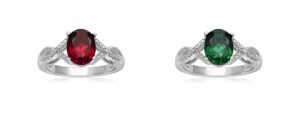When you walk into most jewelry stores, you are first overwhelmed by the sheer volume of beauty. So you go to another. And another. Eventually, you realize that you keep seeing the same things. Although beautiful, you find yourself wanting more. When you look at a piece of jewelry in the case, your mind wanders down the path of “I wish I could swap out that ruby for an emerald...I wish that ring held a princess cut diamond instead of a round…I wish I could design exactly what I want.”
Most jewelry stores will tell you that they can absolutely do “that;” they can do your custom work. However, often what they mean is that they can personalize and customize existing pieces of jewelry to suit your taste. That is because most jewelry stores are simply retail outlets, not full jewelers who craft your piece in-house from conception to reality. But that is a different blog for a different day. Today, we will be exploring the difference between personalization, customization, and custom work. They are often used interchangeably, despite their true and real differences. They each have distinct characteristics.
Let’s go back to our shopping example. In the jewelry store, when your mind wandered to, “I wish I could swap out that ruby for an emerald,” that is a perfect example of personalization. When we talk about personalization, what we mean is a small change is being made that does not change the form and function of the jewelry. A stone being swapped out doesn’t make a custom piece. Let’s assume we’re talking about a ring. In our example, we want an emerald instead of a ruby. So all that needs to be done is to take out that ruby and put a comparably-sized emerald in its place. This change is relatively simple and fast.

Switching out one stone for another in a pre-existing ring is an example of personalization.
Customization takes personalization a little farther. In our example, customization would be akin to “I wish that ring held a princess cut diamond instead of a round.” Customization means some changes are being made to the form of the ring. These alterations are usually more in-depth and depending on what the changes require, some jewelry retailers will not have the skills, workspace, or equipment necessary to complete them in-house. Swapping out a differently shaped stone may seem simple, but it actually requires a considerable amount of work.
Let’s assume our stone is held by standard prongs. An oval-cut diamond usually has six prongs, but a cushion-cut (rounded square cut) generally only has four prongs. And because those prongs are literally only holding onto the corners of the diamond, the prongs are thicker (to promote strength) than those of prongs that hold oval stones. Getting back to our example, an oval-cut diamond will be held in place by a “head” that is suited to holding oval-cut diamonds. A jeweler will need to carefully remove that head and put in a new one. This means they have to file, grind, and solder the head and shank (that’s the part of the ring that wraps around the bottom and sides of your finger) together. Next, the stone can be set in the new head and finally, the whole piece can be polished and cleaned. It is a pretty involved process. But still, it is just customization. The bulk of the piece was left intact, even though significant changes were made to one area.
So where does that leave us with regard to the meaning of “custom work?” Custom work is my favorite. I have always had a very defined sense of style, and as a result, sometimes the only way to get exactly what I’m looking for is to have a custom piece of jewelry made. When I say custom, I mean truly and totally unique.

The process of creating a custom ring from scratch. An idea outline (left), a screengrab of the CAD/CAM design (center) and finally the finisihed product (right)
With a custom design, your piece starts from scratch. You can bring in your idea, whether it’s a crudely drawn scribble on a Post-It or a CAD design you drafted on the computer, and André (the owner and expert jeweler at Andre’s Fine Jewelers) and his trained staff can guide you and transform your idea into a tangible masterpiece. With custom work, the design is born out of a collaboration between you and the jeweler.
But we're getting ahead of ourselves. Let's back up to the CAD (computer aided design and drafting) design. There are a handful of jewelry designing software, but the simple types only give you the illusion of custom design. They rely on predetermined options that the jeweler can assemble before your ideas. In these software, which are essentially just computer aided customization machines (not true CAD software), the jeweler doesn't need to understand arcs, radii, or the features your lifestyle necessitates. All he has to do is create a collage.
Not at Andre's Fine Jewelers. We use a sophisticated and professional-grade CAD program called Matrix. The capabilities of the program allow Andre's expertise to shine. For example, if you need to wear latex gloves often in your line of work, Andre can design, from scratch, a ring with a lower profile so the center stone doesn't sit too high and catch your glove. Or we can create just the right curve so that the ring appears to flow with your finger. These are things that can only be done by an artist who has chosen jewelry as his medium and who uses the complex engineering principles and tools that define mastery of his craft. THAT is what defines true custom design.
When all is said and done, there is only one piece like yours. THAT is custom work. From start to finish, the piece is made completely and solely for you. And if you are accustomed to shopping at a jewelry store owned by an actual jeweler, like Andre’s Fine Jewelers, most of what you see in the showroom was created in the same manner. Almost all the pieces of art in the store were made as unique pieces. What you see at Andre’s Fine Jewelers will not be found in other stores.

A true custom made piece is made from scratch using either traditional wax carving techniques or by using a CAD/CAM program depending on the project
When shopping for jewelry, it is crucial to be informed. Personalization, customization, and custom work all have their places in the jewelry world. But know that they are distinct concepts and for the best possible results, you should skip the jewelry retailers and go straight to the source for custom jewelry: Andre’s Fine Jewelers.





